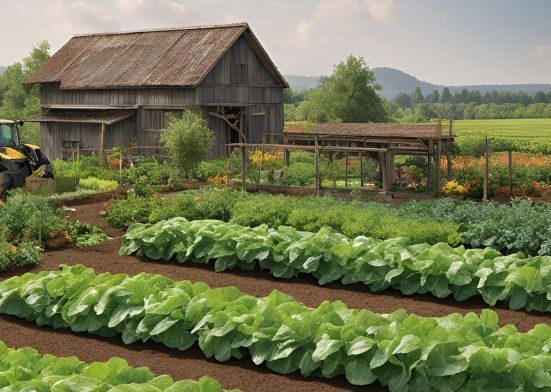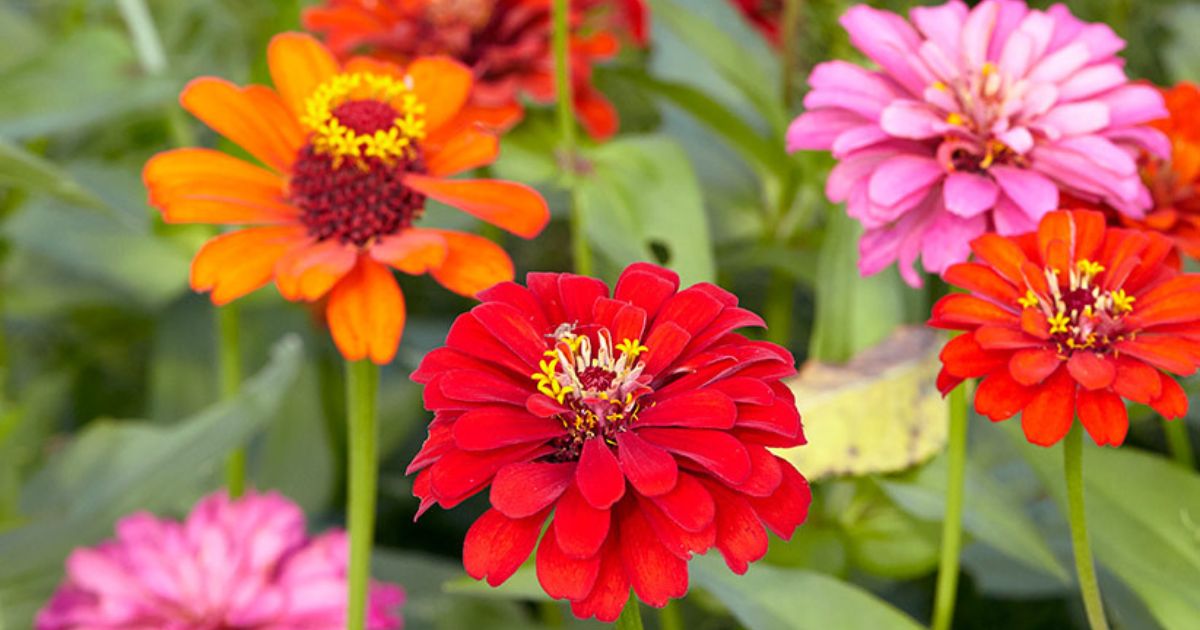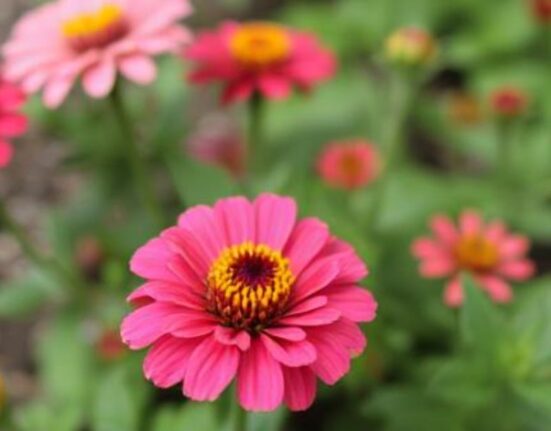Zinnias are among the most beloved and vibrant garden flowers, known for their bold colors, easy growing habits, and ability to attract pollinators like bees and butterflies. Whether you’re a beginner or an experienced gardener, zinnias make a rewarding addition to any flower bed, border, or container. But one of the most common questions gardeners ask is: Do zinnias like sun or shade? The answer is crucial to growing lush, colorful blooms throughout the season. In this comprehensive guide, you’ll learn everything you need to know about how to grow zinnia flowers, including sun requirements, soil preferences, watering tips, planting methods, common problems, and more.
What Are Zinnias?
Zinnias are vibrant, daisy-like flowers known for their bold colors and long-lasting blooms. Native to Mexico and the southwestern United States, these annual plants thrive in warm climates and are beloved for their easy-care nature. Zinnias come in a wide range of colors, including red, pink, orange, yellow, white, and even green, and bloom in various forms, such as single, double, and semi-double. Their ability to bloom from early summer until the first frost makes them a favorite for gardeners seeking continuous color.
Zinnias attract pollinators, such as butterflies and bees, making them a valuable addition to any pollinator-friendly garden. They grow best in full sun and well-drained soil, and they are relatively drought-tolerant once established. Whether planted in flower beds, borders, or containers, zinnias bring a cheerful, eye-catching burst of color and are also excellent as cut flowers. Their fast growth and minimal zinnia flower maintenance make them ideal for both beginners and experienced gardeners.
- Cutting gardens
- Pollinator-friendly beds
- Edging walkways
- Mass plantings
- Container gardens
Do Zinnias Like Sun or Shade?
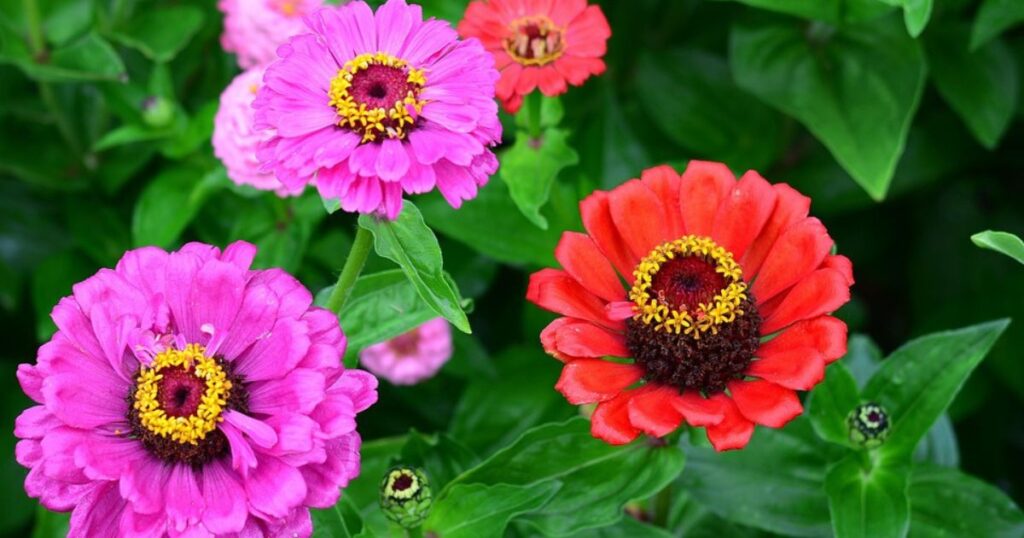 Zinnias are sun-loving flowers that thrive best in full sunlight. They require at least 6 to 8 hours of direct sunlight each day to bloom vibrantly and grow strong, healthy stems. Full sun exposure not only encourages continuous flowering but also helps prevent common issues, such as powdery mildew. Zinnias can tolerate some shade, particularly in warmer climates, but excessive shade will cause them to develop slowly and produce fewer blooms. These bright, cheerful flowers are native to warm, sunny regions, making them perfect for summer gardens.
Zinnias are sun-loving flowers that thrive best in full sunlight. They require at least 6 to 8 hours of direct sunlight each day to bloom vibrantly and grow strong, healthy stems. Full sun exposure not only encourages continuous flowering but also helps prevent common issues, such as powdery mildew. Zinnias can tolerate some shade, particularly in warmer climates, but excessive shade will cause them to develop slowly and produce fewer blooms. These bright, cheerful flowers are native to warm, sunny regions, making them perfect for summer gardens.
Whether grown in garden beds, borders, or containers, zinnias thrive best in well-draining soil with full sun exposure. To maximize their colorful display, plant them in open areas where they can soak up the sun. If you’re looking for easy-to-grow, sun-loving flowers that attract butterflies and pollinators, zinnias are a top choice for gardeners of all experience pictures of zinnias levels.
Why Zinnias Prefer Full Sun:
- Better bloom production: Direct sunlight promotes more flowers and vibrant colors.
- Healthier growth: Full sun helps prevent leggy or weak stems.
- Disease resistance: Sunny conditions improve air circulation, reducing the risk of mildew or fungal diseases.
Can Zinnias Tolerate Shade?
- Partial shade (less than 4 hours of direct sun): Zinnias may survive, but growth will be weak and flowering will be minimal.
- Full shade: Not suitable at all. Zinnias will become spindly, with few or no flowers, and are more prone to disease.
Best Zinnia Varieties for Your Garden
Zinnias are vibrant, easy-to-grow flowers that add a burst of color to any garden. With so many options, picking the ideal ones will rely on your goal, style, and available space. For bold blooms, Zinnia elegans varieties like ‘Benary’s Giant’ offer large, double flowers in vivid shades—perfect for cutting gardens. If you’re looking for compact options, ‘Profusion’ series zinnias are ideal; they’re disease-resistant and bloom continuously in smaller spaces or containers.
For something unique, try ‘Queen Lime’ or ‘Zinderella’ varieties, which feature rare, pastel tones and scabiosa-like forms. Gardeners who want pollinator-friendly choices can’t go wrong with ‘Persian Carpet’—a dwarf mix with rich, warm hues loved by butterflies. Whether you’re designing a border, filling pots, or planning a cut-flower patch, these top zinnia picks provide reliable performance, long-lasting blooms, and a rainbow of color all season how tall do zinnias grow zinnia perennial long.
Tall Varieties:
- Benary’s Giant – Excellent for cut flowers; large, double blooms in vivid shades.
- California Giant – Huge flowers up to 5 inches wide; ideal for back-of-the-border displays.
Medium-Height Varieties:
- Zahara™ Series – Disease-resistant and compact; thrives in hot, sunny gardens.
- Profusion Series – A hybrid of Zinnia elegans and Zinnia angustifolia; excellent disease resistance and continuous bloom.
Dwarf Varieties:
- Thumbelina – Perfect for borders or containers; grows 6–12 inches tall.
- Lilliput Mix – Small, button-like blooms; great for smaller spaces or edging.
Preparing the Soil
Soil preparation is a crucial first step in any successful gardening or farming project. Healthy, well-prepared soil provides the foundation for strong root development, effective nutrient absorption, and enhanced plant resilience. The process begins by clearing the area of weeds, rocks, and debris to provide a clean space for planting. Next, the soil should be loosened by tilling or digging to improve aeration and drainage, allowing roots to grow freely. Compost, aged manure, or peat moss are examples of organic materials that can be added to soil to strengthen its structure and replenish it with vital nutrients.
Testing the soil’s pH helps determine whether any additions, such as sulfur or lime, are required to balance the acidity or alkalinity. Finally, leveling the soil ensures even water distribution and promotes uniform plant growth. Taking the time to prepare the soil properly leads to healthier plants, higher yields, and a more october flower productive growing season zinnias sun or shade overall.
Soil Requirements:
- Type: Loamy or sandy
- pH level: Neutral to slightly acidic (6.0–7.5)
- Drainage: Essential; soggy soil encourages rot and mildew
How to Prepare the Soil:
- Loosen the top 8–10 inches with a garden fork or tiller.
- Amend with compost or aged manure to add nutrients and improve structure.
- Avoid over-fertilizing with high-nitrogen products, which produce lush foliage but fewer blooms.
How to Plant Zinnias (From Seed or Seedling)
Planting zinnias is a rewarding and straightforward way to add vibrant color to your garden. Whether you start from seed or seedlings, these sun-loving annuals thrive in warm weather and well-drained soil. To plant from seed, wait until after the last frost, then sow seeds directly in the garden, spacing them 6–18 inches apart, depending on the variety. Lightly cover with soil and keep the soil moist until germination, which usually occurs within 5–7 days.
For seedlings, transplant them into the garden once the earth has warmed and the risk of frost has passed. Plant in holes that are just a little bit bigger than the root ball and at the same depth. In the container. Water well after planting and provide full sun for at least 6 hours daily. Zinnias grow quickly and bloom in just a few weeks, making them perfect for Lilac Flower: Meaning Growing Tips and Seasonal Beauty cut flower gardens, borders, and pollinator-friendly landscapes.
Direct Sowing (Best Method):
- When to plant: After the last frost, when the soil is warm (60°F/16°C or higher).
- How: Sow seeds ¼ inch deep and 6–12 inches apart, depending on variety.
- Germination: Takes 5–10 days.
- Thinning: Once seedlings emerge, thin them to proper spacing to prevent overcrowding.
Starting Indoors:
- Start 4–6 weeks before your last frost date in seed trays or peat pots.
- Transplant only after hardening off and when temperatures stay consistently warm.
Watering and Fertilizing Zinnias
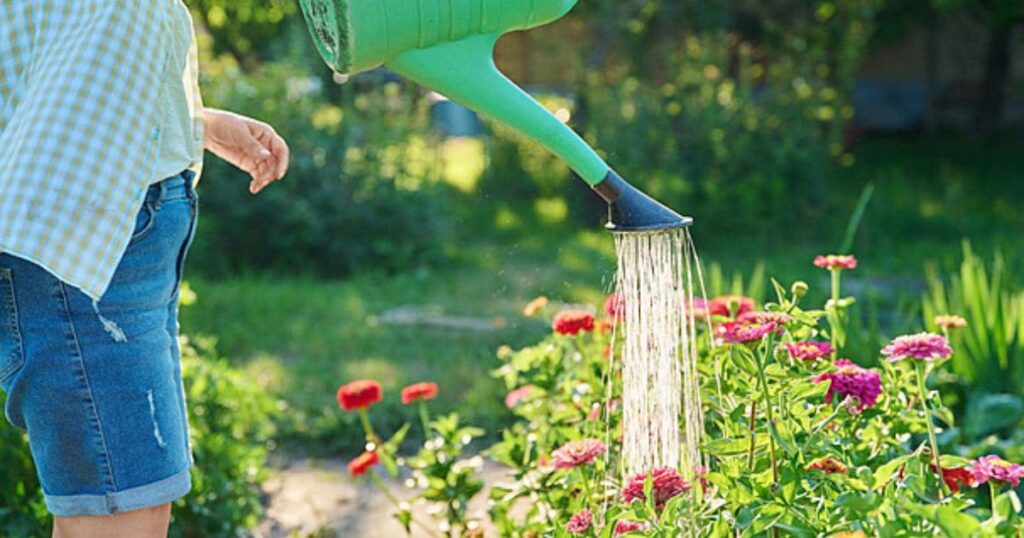 Zinnias thrive with consistent care, particularly in terms of watering and fertilizing. These vibrant flowers prefer well-drained soil and should be watered at the base to avoid wetting the foliage, which can lead to disease. Aim to water deeply once or twice a week, depending on rainfall and temperature, allowing the soil to dry slightly between waterings. Root rot can be caused by overwatering; thus, proper drainage is zinnia flower crucial.
Zinnias thrive with consistent care, particularly in terms of watering and fertilizing. These vibrant flowers prefer well-drained soil and should be watered at the base to avoid wetting the foliage, which can lead to disease. Aim to water deeply once or twice a week, depending on rainfall and temperature, allowing the soil to dry slightly between waterings. Root rot can be caused by overwatering; thus, proper drainage is zinnia flower crucial.
For optimal growth and continuous blooming, apply a water-soluble, balanced fertilizer during the growing season, using it every two to four weeks. Alternatively, you can use a slow-release granular fertilizer at the time of planting. Be cautious not to over-fertilize, as this may result in lush foliage but fewer blooms. Healthy, well-fed zinnias reward gardeners with abundant, colorful flowers all summer long. With proper hydration and nutrients, zinnias flourish and remain a stunning focal point in any zinnia flower profusion zinnia garden.
Watering Tips:
- Frequency: 1 inch of water per week (more during extreme heat).
- Method: Place water at the base to avoid wetting the leaves.
- Mulching: Add a 1–2 inch layer of mulch to retain moisture and reduce weeds.
Fertilizing Tips:
- Start with compost when planting.
- Mid-season feeding: Use a balanced (10-10-10) or bloom-boosting fertilizer every 3–4 weeks.
- Avoid over-fertilizing: excessive nitrogen can reduce blooms.
Caring for Zinnias Throughout the Season
Zinnias are vibrant, low-maintenance flowers that reward gardeners with a long season of colorful blooms. To keep them thriving from spring through fall, start by planting them in well-draining soil under full sun. Regular watering is key—especially during dry spells—but avoid wetting the foliage to prevent mildew. Deadhead spent blooms consistently to encourage new flowers and extend the blooming period. For bushier growth, pinch back young plants early in the season.
Apply a balanced, slow-release fertilizer every 4–6 weeks to promote healthy foliage and continuous flowering. Keep an eye out for common pests, such as aphids and spider mites, and treat them promptly with insecticidal soap or neem oil. As the season progresses, taller varieties may need Staking for support. With proper care and attention, zinnias will brighten up your garden beds or containers with dazzling, long-lasting color until the first zinnia full sun frost.
Tips for Healthy Zinnias:
- Deadhead regularly: Removing spent blooms encourages more blooms to flower.
- Pinch back young plants to promote bushier growth.
- Support taller varieties by Staking or caging them to prevent flopping in windy areas.
Preventing Pests and Diseases
Preventing Pests and Diseases is a crucial part of maintaining a healthy and productive garden or farm. By taking proactive measures, gardeners can reduce the risk of infestations and infections that damage plants and reduce yields. Start by choosing disease-resistant plant varieties and rotating crops to avoid soil-borne problems. Keep your garden clean by removing weeds, fallen leaves, and decaying plant matter that may harbor pests. Encourage beneficial insects, such as ladybugs and lacewings, that naturally control harmful pests. Proper spacing and pruning enhance air circulation, which helps prevent fungal diseases.
By reducing the amount of moisture on leaves, watering plants at their bases rather than overhead helps stop the spread of rot and mildew. Frequent inspections enable prompt intervention by identifying issues early. As a last resort, consider applying chemical or organic therapies if necessary. Consistent care and monitoring create a resilient garden ecology that can naturally ward off illnesses and pests before they become significant do zinnias need full sun problems.
Common Pests:
- Aphids: Small, soft-bodied insects on stems and leaves.
- Spider mites: Fine webbing and speckled leaves.
- Japanese beetles: Eat petals and leaves.
Control tips:
- Spray with neem oil or insecticidal soap.
- Encourage ladybugs and lacewings.
- Handpick beetles in the morning.
Common Diseases:
- Powdery mildew: White, powdery coating on leaves.
- Alternaria leaf spot: Brown circular spots on lower leaves.
- Bacterial wilt: Sudden wilting and yellowing.
Prevention tips:
- Water at the base, not overhead.
- Space plants for airflow.
- Choose disease-resistant varieties (like Profusion and Zahara).
Zinnias in Pots and Containers
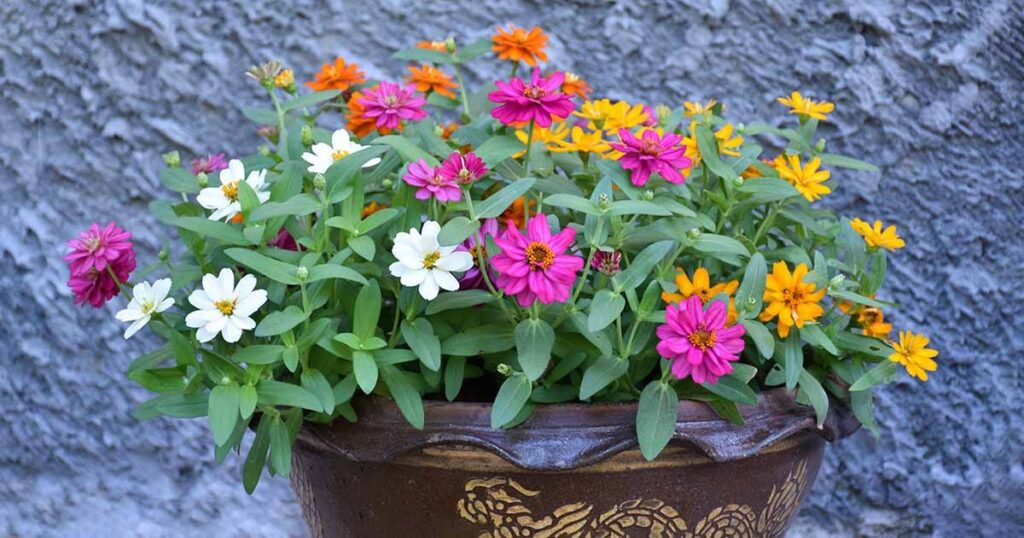 Growing zinnias in pots and containers is a images of zinnias vibrant way to add color and cheer to patios, balconies, and small garden spaces. These sun-loving annuals thrive in well-draining containers filled with quality potting mix. With their bold blooms in shades of red, pink, orange, yellow, and white, zinnias make an eye-catching display that lasts all summer long. Compact varieties, such as ‘Thumbelina’ or ‘Profusion’, are especially well-suited for container gardening, remaining neat and manageable while producing an abundance of flowers.
Growing zinnias in pots and containers is a images of zinnias vibrant way to add color and cheer to patios, balconies, and small garden spaces. These sun-loving annuals thrive in well-draining containers filled with quality potting mix. With their bold blooms in shades of red, pink, orange, yellow, and white, zinnias make an eye-catching display that lasts all summer long. Compact varieties, such as ‘Thumbelina’ or ‘Profusion’, are especially well-suited for container gardening, remaining neat and manageable while producing an abundance of flowers.
Ensure your containers are placed in an area that receives at least six hours of direct sunlight daily. Regular watering, deadheading spent blooms, and applying fertilizer sporadically with a balanced formula will help maintain your potted zinnias as healthy and blooming as possible. Whether arranged in single pots or grouped in colorful clusters, zinnias bring life and charm to any space. Their low-maintenance care and continuous blooms make them a perfect choice for both beginner and seasoned zinnia flower gardeners.
Potting Guidelines:
- Container size: At least 8–12 inches deep.
- Soil: Use a high-quality, well-draining potting mix.
- Placement: Full sun, ideally 6 hours or more per day.
- Watering: Monitor daily during hot weather, but avoid letting the soil stay soggy.
Zinnias in containers are great for balconies, atrios, or small gardens. They also make easy-to-move pollinator stations.
Companion Planting With Zinnias
Companion planting with zinnias is a vibrant and effective gardening strategy that benefits both flowers and vegetables. Zinnias attract beneficial insects such as pollinators—bees and butterflies—and predatory insects like ladybugs and lacewings, which help control pests naturally. Planting zinnias near vegetables like tomatoes, peppers, and cucumbers can increase pollination rates, resulting in improved fruit production. Additionally, zinnias serve as a trap crop, drawing aphids and other pests away from more vulnerable plants.
Their bright, cheerful blooms also add aesthetic appeal to vegetable beds and garden borders. Zinnias thrive in full sun and well-drained soil, making them easy to grow alongside many common garden plants. By incorporating zinnias into your garden, you create a healthier, more balanced ecosystem that supports plant growth, reduces the need for chemical pest control, and enhances biodiversity. Companion planting with zinnias is a simple yet powerful way to improve your garden’s productivity and are zinnias annuals or perennials beauty.
Good Companions:
- Tomatoes: Zinnias attract pollinators and deter tomato hornworms.
- Cucumbers and squash: Zinnias attract bees for improved fruit set.
- Basil and mint: These herbs help repel pests.
- Marigolds and cosmos: Create a pollinator paradise with other bright bloomers.
Avoid planting near:
- Highly aggressive ground covers: They can compete for sunlight and nutrients.
How to Harvest and Save Zinnia Seeds
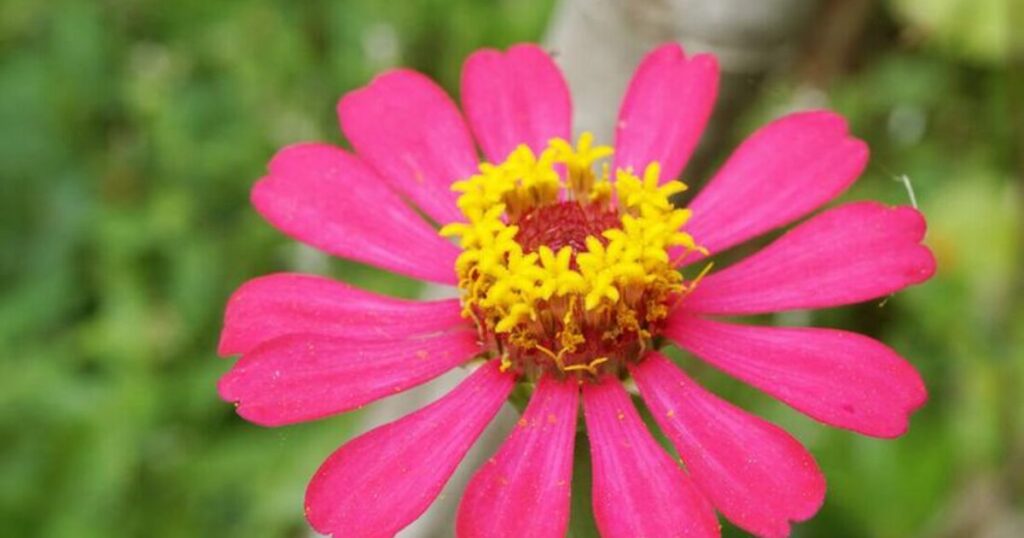 Harvesting and saving zinnia seeds is a simple way to enjoy these vibrant flowers year after year. Begin by allowing zinnia blooms to fully mature and dry on the plant, turning brown and crisp. Once dried, gently remove the flower heads and place them in a paper bag to continue drying if needed. After a few days, carefully break apart the dried flower heads to collect the tiny, black, elongated seeds found inside. Ensure the seeds are dehydrated before storing to prevent mold growth.
Harvesting and saving zinnia seeds is a simple way to enjoy these vibrant flowers year after year. Begin by allowing zinnia blooms to fully mature and dry on the plant, turning brown and crisp. Once dried, gently remove the flower heads and place them in a paper bag to continue drying if needed. After a few days, carefully break apart the dried flower heads to collect the tiny, black, elongated seeds found inside. Ensure the seeds are dehydrated before storing to prevent mold growth.
Store the seeds in a cool, dry, and dark place, preferably in a paper envelope or an airtight container with a desiccant packet to prevent moisture from accumulating. Properly stored zinnia seeds can remain viable for several years, ready to be planted in the next growing season. This simple process ensures a continuous supply of beautiful zinnias in your garden without additional zinnias near me cost.
Harvesting Flowers for Bouquets:
- Cut stems early in the morning for best freshness.
- Use sharp scissors and place stems in water immediately.
- Zinnias last up to 7–10 days in a vase.
Saving Seeds:
- Let some flowers dry on the stem until brown and brittle.
- Snip off the heads and allow them to dry completely in a paper bag.
- Gently separate seeds and store them in labeled envelopes in a cool, dry place.
Conclusion:
In conclusion, zinnia flower thrive best when provided with ample sunlight. These vibrant, easy-to-grow blooms prefer full sun exposure—ideally at least 6 to 8 hours daily—to develop strong stems and abundant flowers. At the same time, zinnias can tolerate some light shade, but too much shade results in leggy growth and fewer blossoms. To grow healthy zinnias, select a well-draining pot that receives ample sunlight. Water them regularly, but avoid overwatering. Additionally, provide good air circulation to prevent the spread of diseases.
With the right conditions, especially full sun zinnias will reward you with cheerful, colorful blooms all summer long. Whether you’re planting in beds, borders, or containers, understanding their sun preference is key to success. So, for a flourishing zinnia garden, let the sun shine bright and watch your flowers flourish beautifully!
FAQ:
Do Zinnia Flowers prefer sun or Shade?
Zinnias thrive best in full sun. They require at least 6 to 8 hours of direct sunlight daily to grow strong, bloom abundantly, and maintain vibrant colors.
Can Zinnias Grow in Partial Shade?
While zinnias can tolerate some light shade, especially in very hot climates, too much shade will cause them to become leggy and produce fewer flowers.
What is the Ideal Amount of Sunlight for Zinnias?
Full sun exposure—meaning direct sunlight for most of the day—is ideal. Aim for a minimum of 6 hours, but 8 hours or more is better for optimal growth.
What Happens if Zinnias don’t get Enough Sunlight?
Without sufficient sun, zinnias may grow tall and spindly with sparse blooms—their overall health and flower production decline in shady conditions.
Can Zinnias Tolerate Heat and Drought?
Yes! Zinnias thrive in warm weather and are quite drought-tolerant once established, but they still require regular watering during prolonged dry spells.




